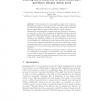Free Online Productivity Tools
i2Speak
i2Symbol
i2OCR
iTex2Img
iWeb2Print
iWeb2Shot
i2Type
iPdf2Split
iPdf2Merge
i2Bopomofo
i2Arabic
i2Style
i2Image
i2PDF
iLatex2Rtf
Sci2ools
IWINAC
2007
Springer
2007
Springer
Evolving Robot Behaviour at Micro (Molecular) and Macro (Molar) Action Level
We investigate how it is possible to shape robot behaviour adopting a molecular or molar point of view. These two ways to approach the issue are inspired by Learning Psychology, whose famous representatives suggest different ways of intervening on animal behaviour. Starting from this inspiration, we apply these two solutions to Evolutionary Robotics’ models. Two populations of simulated robots, controlled by Artificial Neural Networks are evolved using Genetic Algorithms to wander in a rectangular enclosure. The first population is selected by measuring the wandering behaviour at micro-actions level, the second one is evaluated by considering the macro-actions level. Some robots are evolved with a molecular fitness function, while some others with a molar fitness function. At the end of the evolutionary process, we evaluate both populations of robots on behavioral, evolutionary and latent-learning parameters. Choosing what kind of behaviour measurement must be employed in an evo...
| Added | 08 Jun 2010 |
| Updated | 08 Jun 2010 |
| Type | Conference |
| Year | 2007 |
| Where | IWINAC |
| Authors | Michela Ponticorvo, Orazio Miglino |
Comments (0)

